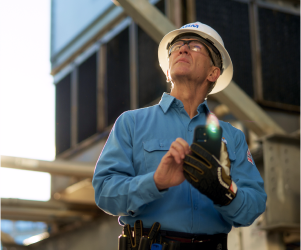Posted by Johann Nacario — November 1, 2022 — Owl Labs, creator of cutting-edge artificial intelligence (AI)-powered, 360-degree video conferencing solutions, in collaboration with leading remote work research and consulting firm Global Workplace Analytics, has just released its sixth annual State of Remote Work report. Owl Labs surveyed more than 2,300 full-time workers across the United States to uncover the latest trends and perspectives around remote and hybrid work, from employee tracking software to the four-day workweek.
The report reveals what drives employees to quit (and “quiet quit”), the amounts of money that in-office workers shell out on everything from lunch to pet care, the decline of the open plan office, and the rise of task-based hybrid work. It also explores burnout and stress, particularly about a possible recession. The data shows that flexibility, versus fully remote work, is the new norm and what employees really want. Employers are delivering on staff members’ requests to work where they want by allowing a range of in-person and remote options, resulting in more inclusive hybrid environments.
Frank Weishaupt, CEO of Owl Labs, remarked:
Workplace trends are continuing to evolve rapidly, even three years after the pandemic began. Priorities and preferences have evolved for both workers and employers in the past year, bringing flexible and hybrid work to the forefront, even as some companies have continued to attempt a “return to the office” push each fall since 2020. This new data shows that successful businesses need to present a range of hybrid options and technologies to keep workers happy and productive, as one-size-fits-all remote or in-person policies don’t allow everyone to do their best work. Listening to employees is crucial as companies iterate on their policies, practices and product solutions to align with team members’ needs.
More people want remote and hybrid work, and employers are trying to catch up
Some companies may be trying to lure workers back to the office again this fall, but employees want the flexibility they’ve become accustomed to over the past few years. The percentage of workers who want to be remote full-time increased by eight percentage points since last year to 42%, and 36% of employees now want to be hybrid, up five percentage points. The vast majority (86%) say remote work would make them happier, and 62% feel more productive when working remotely. The call to come back to the office is loudest among smaller companies — 41% of small businesses (10-50 employees) are requiring people to return to the office, compared to 27% of enterprises (10,000+ employees).
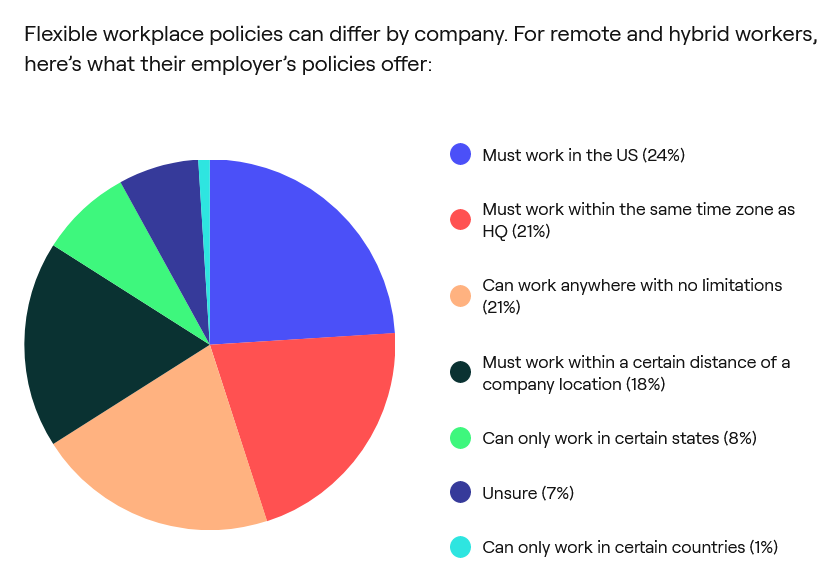
The flexibility that employees want is slowly becoming the norm — workers reported that prior to the pandemic, only 8% of their companies had flexible policies whereas today, almost two-thirds (62%) say their company has implemented at least some degree of flexible work. Mid-sized companies (501 to 5,000 employees) are leading the way with 70% offering flexible work policies — more than any other size company. Some employers remain unprepared though, with only half (50%) training managers on how to lead remote and hybrid teams and 54% teaching workers how to hold effective and inclusive hybrid meetings.
Task-based hybrid work allows employees to do different tasks in the best environment
Task-based hybrid work, where your location depends on the type of task you’re doing, gives people the freedom to choose their locations based on their own individual schedules and tasks, allowing teams to get the best of both worlds and optimize productivity. Nearly half of workers (49%) say they can meet deadlines better when remote, versus 31% who like to reach deadlines in-office. When it comes to meetings, more than half of workers (51%) say team meetings are more productive at the office, while a quarter (25%) prefer joining team meetings remotely. Additionally, 39% of workers say they are more productive when brainstorming and innovating at the office, while 37% prefer remote brainstorms.
Office design is changing, with coworking spaces becoming a popular “third place” between office and home
Since the pandemic began, many companies have transformed their physical office spaces, from square footage to location to design, and 37% have hired someone to manage the workplace experience for on-site or remote employees. More than 1/3 of employers (37%) have closed offices or decreased office space and 13% have opened smaller satellite offices, while 14% of employees say their company provides access to a “third place,” like a coworking space, as a middle ground between home and office. Office design is changing, too — 15% of companies have shifted to “hot desking,” where employees don’t have a permanent desk and need to reserve workspaces.
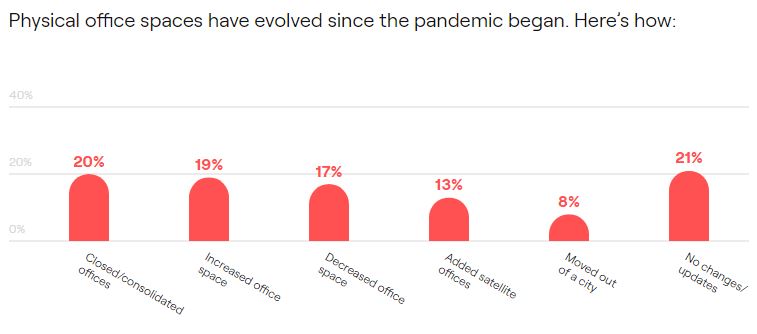
The age of the open office is in decline, as 68% of employees say more privacy would make them more inclined to go to work in person. Despite the increase in hybrid meetings with both in-office and remote participants, only about one in five companies (19%) have expanded their collaboration and meeting spaces, and 1/3 (36%) have upgraded their video meeting technology.
Going to the office costs employees twice as much as working remotely
More than 1/4 of employees (28%) feel that they should be paid more to work remotely, with another 57% saying they should be paid the same regardless of where they do their jobs. Only 14% said they should be paid more for office work. In reality, while many companies provide monthly stipends to cover remote work expenses, it actually costs employees more money to commute to the office.
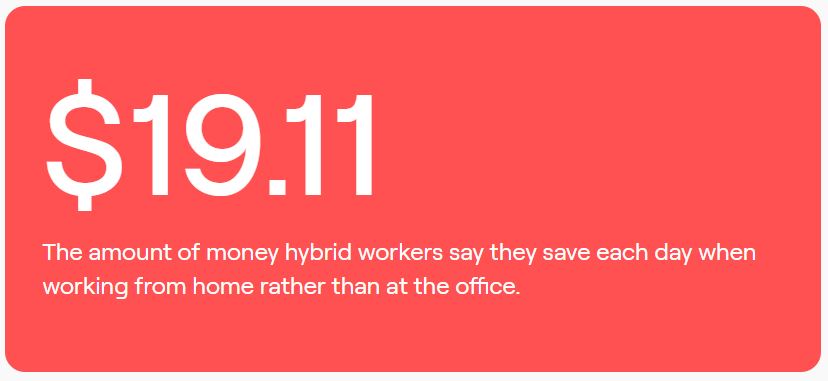
Employees spend twice as much money at the office ($862 / month) versus working remotely ($431 / month). The top costs for in-office workers per day include commuting ($14.60), lunch ($13.07), dinner ($10.98), and breakfast or coffee ($6.29). Office workers are also spending on their furry friends at home, with an average of $16 per day going towards pet care, such as dog walking. Three in four workers (75%) say they’d be more inclined to go to the office if their companies paid for their commuting costs, like parking, and 69% would be lured to the office by free food and beverages.
Workers are worried about “proximity bias” – and their fears aren’t unfounded
Employees now have more choices than ever in how they work, and this means they are newly concerned that in-person colleagues may advance quicker and have advantages over remote team members due to “proximity bias” — meaning physical proximity to the in-office boss. More than half of workers (51%) think the office is the best place for advancing their careers, compared to 31% who think remote locations are best. Nearly half of employees (49%) believe they won’t be able to build relationships with leadership team members while working remotely.
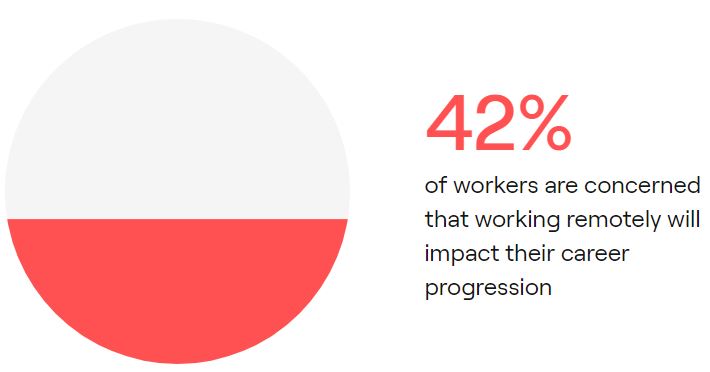
These fears are valid, as more than half of workers (51%) admit to preferring to manage others in person versus remotely (25%), and nearly half (49%) are more likely to ask the opinion of their colleagues in person over their remote team members. This data shows why it’s crucial for employers to invest in the right technology, management training and policies to ensure that remote workers feel included and aren’t disadvantaged compared to employees in the office.
Employee stress has increased, especially due to recession fears and return to office demands
Amid all these changes, almost half (45%) of employees say their work-related stress has increased in the past year. Among workers experiencing more stress, the leading cause is being back in the office, with 53% saying it’s their biggest concern. About half of these workers (49%) with higher stress levels are concerned they will not be given the flexibility they want and 45% are worried they will be forced to go back to the office full-time. Many employees are also anxious about job stability in this unpredictable economy, with 58% feeling concerned about an impending recession, which is 9 percentage points higher than any other source of work-related stress. In light of anxiety and burnout running rampant, it’s no surprise the four-day work week model is appealing to employees, with 80% wanting to try it out.
Companies are eroding trust with employee tracking software and flip-flopping on policies
Another source of stress, which affects 45% of workers, is being monitored by employers. While 75% of employees say that working from home would make them feel more trusted, and 62% feel more productive when remote, 60% of managers think remote workers are less productive. Due to this mistrust, more than 1/3 of companies (37%) have added or increased their usage of employee activity tracking software since the pandemic began.
In light of some companies pulling a “bait and switch” by offering hybrid and remote options and then requiring people to come to the office instead, 9% of workers believe their employer is likely to get rid of their flexible work policy, and 11% are completely unsure of their company’s plans. The data shows there is room for companies to increase transparency around workplace policies, as only half (53%) have surveyed their employees about remote work preferences, and only 39% of those have actually shared the results with their teams.
The Great Resignation isn’t over yet, and workers are setting boundaries by “quiet quitting” — and actually quitting — when they don’t have the flexibility they want
Despite recession fears, the Great Resignation has continued and about 1/3 (29%) of employees changed jobs within the past year, with remote workers switching roles almost twice as often as those who work in-office. Flexibility is key to retention — nearly half of workers (46%) said if they no longer had remote or hybrid options, they would stay in their role but be less willing to go the extra mile, which some call “quiet quitting.” Going beyond quiet quitting, 39% said they would actually quit if the ability to work from home was taken away and 66% would immediately start looking for a job that offered flexibility. More than half of workers (52%) would take a pay cut of 5% or more and 23% would take a pay cut of 10% or more to have flexibility in their location.
To review the full State of Remote Work 2022 report and detailed findings, please visit Owl Labs.
Owl Labs’ suite of products makes meetings more inclusive and collaborative by leveling the playing field between remote and in-room participants. The company’s flagship product, the Meeting Owl 3, is touted as the first WiFi-enabled, 360-degree camera, microphone and speaker that automatically zooms in on whoever is speaking. To learn more about Owl Labs and its ecosystem of video conferencing solutions for hybrid organizations, visit online.
Kate Lister is president of Global Workplace Analytics, a consulting firm that has been helping organizations optimize remote and hybrid work for nearly two decades. Lister is on the leadership team of IFMA’s Workplace Evolutionaries and is a trusted source of insights about the future of work for news outlets around the globe. She was one of only three witnesses invited to testify before a U.S. Senate committee regarding the post-pandemic potential for remote work in government.
[For additional insights, see “Remote Work Statistics: All the Information You Need about Telecommuting in 2023.”]


